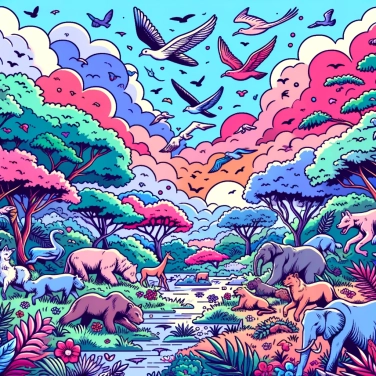Cows ruminate because they have a stomach composed of four compartments, which allows them to perform rumination, a specific digestive process that involves regurgitating and chewing their food multiple times for better nutrient assimilation.

The cow has a digestive system that is very different from ours, featuring a stomach divided into four distinct compartments: the rumen, the reticulum, the omasum (or lamina), and the abomasum (or true stomach). The rumen, the largest compartment, acts as a true fermentation vat, filled with billions of microbes that help break down grass and fibrous plants. This initial microbial digestion is essential, as the cow itself does not directly produce the enzymes needed to benefit from tough plant materials. After passing through this initial fermentation vat, the food is regurgitated in the form of a cud that the cow chews again at leisure: this is the famous process of rumination. Then, everything moves on to the next compartments to gradually complete digestion. Essentially, this unique organization allows cows to efficiently extract a lot of nutrients from a diet primarily composed of grasses that we humans could never directly digest.
The digestive system of cows is very efficient: it is organized into four compartments, and thanks to this, they can extract a maximum of nutrients from fiber-rich plants. When a cow grazes, it swallows quickly without fully chewing. Later, in a calm environment, it regurgitates small balls of food from its rumen (the famous "paunch"), chews them leisurely, and swallows them again. This second chewing (rumination) effectively breaks down the fibers and increases the contact of the food with the bacteria in the rumen. These bacteria then transform the complex fibers into digestible and easily assimilable elements for the animal. Because of this, cows derive much more energy from a simple handful of grass than other animals could.
Ruminating allows cows to extract maximum nutrients and energy from hard-to-digest plant fibers. By chewing their food multiple times, the bacteria in the rumen (the cow's first stomach) have more time and ease to break down these tough fibers like cellulose. As a result, cows more effectively recover the sugars and essential fatty acids produced by these bacteria, providing them with ultra-valuable energy on a daily basis. Ruminating is thus a form of energy optimization that allows for the full utilization of often poor foods like grass and hay, while ensuring the cow has a balanced diet. Not bad for an animal that grazes all day!
Cows take advantage of rumination by being able to efficiently utilize low-nutrition plants such as grass and hay. Their four stomachs allow them to extract the maximum nutrients available, which optimizes their diet with little energy spent constantly searching for something else. Thanks to this process, they can calmly graze on abundant but hard-to-digest resources for most animals. By occupying this niche, they reduce food competition with other species that do not have the capacity to ruminate. This is also beneficial for their survival as it allows them to thrive in varied, sometimes even arid, environments where other animals would struggle to survive. All of this makes ruminating behavior very advantageous from an adaptive and ecological perspective.
During their rumination process, cows naturally produce methane, a potent greenhouse gas. On average, a cow emits about 200 to 500 liters of methane per day!
The repetitive chewing movements during rumination have a calming effect on cows. This explains why a healthy cow appears relaxed and serene while ruminating.
A cow spends about 8 hours a day chewing its cud. Each bite of grass is chewed more than 50 times before it is finally swallowed!
Cows have four different stomach compartments: the rumen, the reticulum, the omasum, and the abomasum. Thanks to this complex digestive system, they can efficiently digest highly fibrous plant materials, such as grass or hay.
Sure! Here’s the translation: "Yes. During rumination, cattle produce methane, a potent greenhouse gas. The livestock sector is thus considered a significant source of atmospheric methane, raising environmental concerns and encouraging the search for more eco-friendly solutions for animal feed."
Cows initially swallow their food quickly to store it in their first stomach, called the rumen. Later, when they are resting safely, they regurgitate and slowly chew this food to aid in the breakdown of plant fibers and optimize nutrient absorption.
Cows generally spend between 6 and 8 hours a day ruminating, divided into several sessions throughout the day. This time can vary depending on their diet, health, and environment.
No, cows are not the only animals that ruminate. Several other animals such as sheep, goats, deer, and giraffes are also ruminants. This digestive process is common to herbivores that have a stomach made up of multiple compartments.
An abnormal rumination can be observed through a notable decrease in the time spent ruminating, a loss of appetite, a significant drop in milk production in dairy cows, gradual weight loss, or symptoms of discomfort and abdominal pain.

No one has answered this quiz yet, be the first!' :-)
Question 1/5